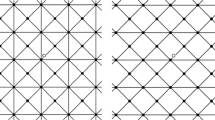Abstract
We investigate a Gibbs (annealed) probability measure defined on Ising spin configurations on causal triangulations of the plane. We study the region where such measure can be defined and provide bounds on the boundary of this region (critical line). We prove that for any finite random triangulation the magnetization of the central spin is sensitive to the boundary conditions. Furthermore, we show that in the infinite volume limit, the magnetization of the central spin vanishes for values of the temperature high enough.


Similar content being viewed by others
References
Ambjørn, J., Anagnostopoulos, K.N., Loll, R.: A new perspective on matter coupling in 2d quantum gravity. Phys. Rev. D 60, 104035 (1999)
Ambjørn, J., Durhuus, B., Fröhlich, J.: Diseases of triangulated random surface models, and possible cures. Nucl. Phys. B 257, 433–449 (1985)
Ambjørn, J., Durhuus, B., Jonsson, T.: Quantum Geometry: A Statistical Field Theory Approach. Cambridge University Press, Cambridge (1997)
Ambjørn, J., Loll, R.: Non-perturbative lorentzian quantum gravity, causality and topology change. Nucl. Phys. B 536, 407–434 (1998)
Baxter, R.J.: Exactly solved models in statistical mechanics. Academic Press. http://tpsrv.anu.edu.au/Members/baxter/book (1982)
Bonzom, V., Gurau, R., Rivasseau, V.: The Ising Model on random lattices in arbitrary dimensions. Phys. Lett. B 711, 88–96 (2012)
Boulatov, D.V., Kazakov, V.A.: The Ising Model on random planar lattice: the structure of the phase transition and the exact critical exponents. Phys. Lett. B 186, 379–384 (1987)
Brézin, E., Douglas, M.R., Kazakov, V., Shenker, S.H.: The Ising model coupled to 2d gravity: a nonperturbative analysis. Phys. Lett. B 237, 43–46 (1990)
David, F.: A model of random surfaces with non-trivial critical behaviour. Nucl. Phys. B 257, 543–576 (1985)
Dembo, A., Montanari, A.: Ising models on locally tree-like graphs. Ann. Appl. Prob. 20, 565–592 (2010)
Durhuus, B., Jonsson, T., Wheater, J.F.: The spectral dimension of generic trees. J. Stat. Phys. 128, 1237–1260 (2007)
Durhuus, B., Jonsson, T., Wheater, J.F.: On the spectral dimension of causal triangulations. J. Stat. Phys. 139, 859–881 (2010)
Durhuus, B., Napolitano, G.M.: Generic Ising trees. J. Phys. A 45, 185004 (2012)
Hernandez, J.C.: Critical region for an Ising model coupled to causal dynamical triangulations. arXiv:1402.3251v3 [math-ph] (2014)
Hernandez, J.C., Suhov, Y., Yambartsev, A., Zohren, S.: Bounds on the critical line via transfer matrix methods for an Ising model coupled to causal dynamical triangulations. J. Math. Phys. 54, 063301 (2013)
Kazakov, V.A.: Ising model on a dynamical planar random lattice: exact solution. Phys. Lett. A 119, 140–144 (1986)
Kazakov, V.A., Kostov, I.K., Migdal, A.A.: Critical properties of randomly triangulated planar random surfaces. Phys. Lett. B 157, 295–300 (1985)
Krikun, M., Yambartsev, A.: Phase transition for the Ising model on the critical Lorentzian triangulation. J. Stat. Phys. 148(3), 422–439 (2012)
Malyshev, V.A.: Gibbs and quantum discrete spaces. Russ. Math. Surv. 56, 917–972 (2001)
Malyshev, V., Yambartsev, A., Zamyatin, A.: Two-dimensional Lorentzian models. Mosc. Math. J. 1, 439–456 (2001)
Acknowledgments
The authors thank Prof. Bergfinnur Durhuus for the helpful discussions on the subject. This work was partially supported by the Swedish Research Council through the Grant No. 2011-5507.
Author information
Authors and Affiliations
Corresponding author
Appendices
Appendix 1: Proof of Lemma 2
Consider the multiple series
with \(k_{n+1}=l\). Summing over \(k_1\) we obtain
where we denoted \(B_1 = (1- x)^{-1}\). Inserting it in the equation and summing over \(k_2\) we obtain
where \(B_2 = (1- x B_1)^{-1}\). Summing over the remaining \(k_i\)’s, we obtain
where \(B_i(x)\) is the solution to the recursion relation
This reads
with
For \(0<x<1/4\), substituting (A.6) into (A.4) we get
which gives
In particular we have
where
This yields the first statement of Lemma 2. The rest follows directly by the results of [20].
Appendix 2: Proof of Corollary 4
We have that, for any \(x \in (0,1/4)\), \(B_i(x)\) is monotonically increasing
Therefore, using that
we obtain that, for any \(i \in \mathbb {N}\) and \(x \in (0,1/4)\),
Now, consider the series
By Eq. (A.4), we have that the series is convergent if and only if
Formula (B.3) together with Lemma 2 yield that the inequality (B.5) is satisfied for any \(n \in \mathbb {N}\) and if and only if \(x \in (0,1/4]\) and
that is
This proves the corollary.
Rights and permissions
About this article
Cite this article
Napolitano, G.M., Turova, T.S. The Ising Model on the Random Planar Causal Triangulation: Bounds on the Critical Line and Magnetization Properties. J Stat Phys 162, 739–760 (2016). https://doi.org/10.1007/s10955-015-1430-7
Received:
Accepted:
Published:
Issue Date:
DOI: https://doi.org/10.1007/s10955-015-1430-7



